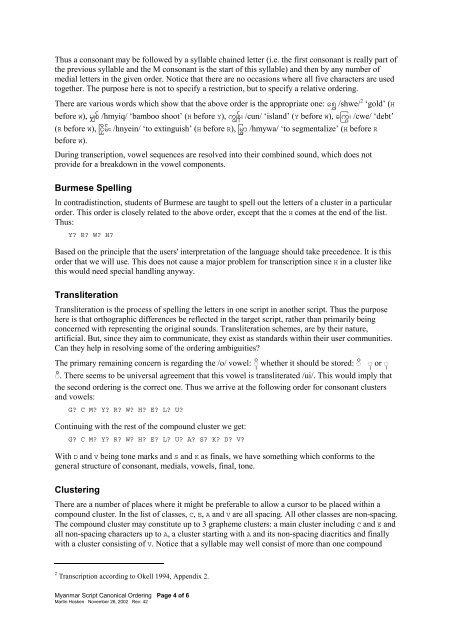Myanmar Script Canonical Ordering - SIL International
Myanmar Script Canonical Ordering - SIL International
Myanmar Script Canonical Ordering - SIL International
Create successful ePaper yourself
Turn your PDF publications into a flip-book with our unique Google optimized e-Paper software.
Thus a consonant may be followed by a syllable chained letter (i.e. the first consonant is really part of<br />
the previous syllable and the M consonant is the start of this syllable) and then by any number of<br />
medial letters in the given order. Notice that there are no occasions where all five characters are used<br />
together. The purpose here is not to specify a restriction, but to specify a relative ordering.<br />
There are various words which show that the above order is the appropriate one: a|Ï /shwe/ 2 ‘gold’ (H<br />
before W), rûpf /hmyiq/ ‘bamboo shoot’ (H before Y), uïef: /cun/ ‘island’ (Y before W), aâu: /cwe/ ‘debt’<br />
(R before W), úidÛrf: /hnyein/ ‘to extinguish’ (H before R), ]rÏm /hmywa/ ‘to segmentalize’ (H before R<br />
before W).<br />
During transcription, vowel sequences are resolved into their combined sound, which does not<br />
provide for a breakdown in the vowel components.<br />
Burmese Spelling<br />
In contradistinction, students of Burmese are taught to spell out the letters of a cluster in a particular<br />
order. This order is closely related to the above order, except that the H comes at the end of the list.<br />
Thus:<br />
Y? R? W? H?<br />
Based on the principle that the users' interpretation of the language should take precedence. It is this<br />
order that we will use. This does not cause a major problem for transcription since H in a cluster like<br />
this would need special handling anyway.<br />
Transliteration<br />
Transliteration is the process of spelling the letters in one script in another script. Thus the purpose<br />
here is that orthographic differences be reflected in the target script, rather than primarily being<br />
concerned with representing the original sounds. Transliteration schemes, are by their nature,<br />
artificial. But, since they aim to communicate, they exist as standards within their user communities.<br />
Can they help in resolving some of the ordering ambiguities?<br />
The primary remaining concern is regarding the /o/ vowel: ýkd whether it should be stored: ýd ýk or ýk<br />
ýd. There seems to be universal agreement that this vowel is transliterated /ui/. This would imply that<br />
the second ordering is the correct one. Thus we arrive at the following order for consonant clusters<br />
and vowels:<br />
G? C M? Y? R? W? H? E? L? U?<br />
Continuing with the rest of the compound cluster we get:<br />
G? C M? Y? R? W? H? E? L? U? A? S? K? D? V?<br />
With D and V being tone marks and S and K as finals, we have something which conforms to the<br />
general structure of consonant, medials, vowels, final, tone.<br />
Clustering<br />
There are a number of places where it might be preferable to allow a cursor to be placed within a<br />
compound cluster. In the list of classes, C, E, A and V are all spacing. All other classes are non-spacing.<br />
The compound cluster may constitute up to 3 grapheme clusters: a main cluster including C and E and<br />
all non-spacing characters up to A, a cluster starting with A and its non-spacing diacritics and finally<br />
with a cluster consisting of V. Notice that a syllable may well consist of more than one compound<br />
2 Transcription according to Okell 1994, Appendix 2.<br />
<strong>Myanmar</strong> <strong>Script</strong> <strong>Canonical</strong> <strong>Ordering</strong> Page 4 of 6<br />
Martin Hosken November 26, 2002 Rev: 42
















